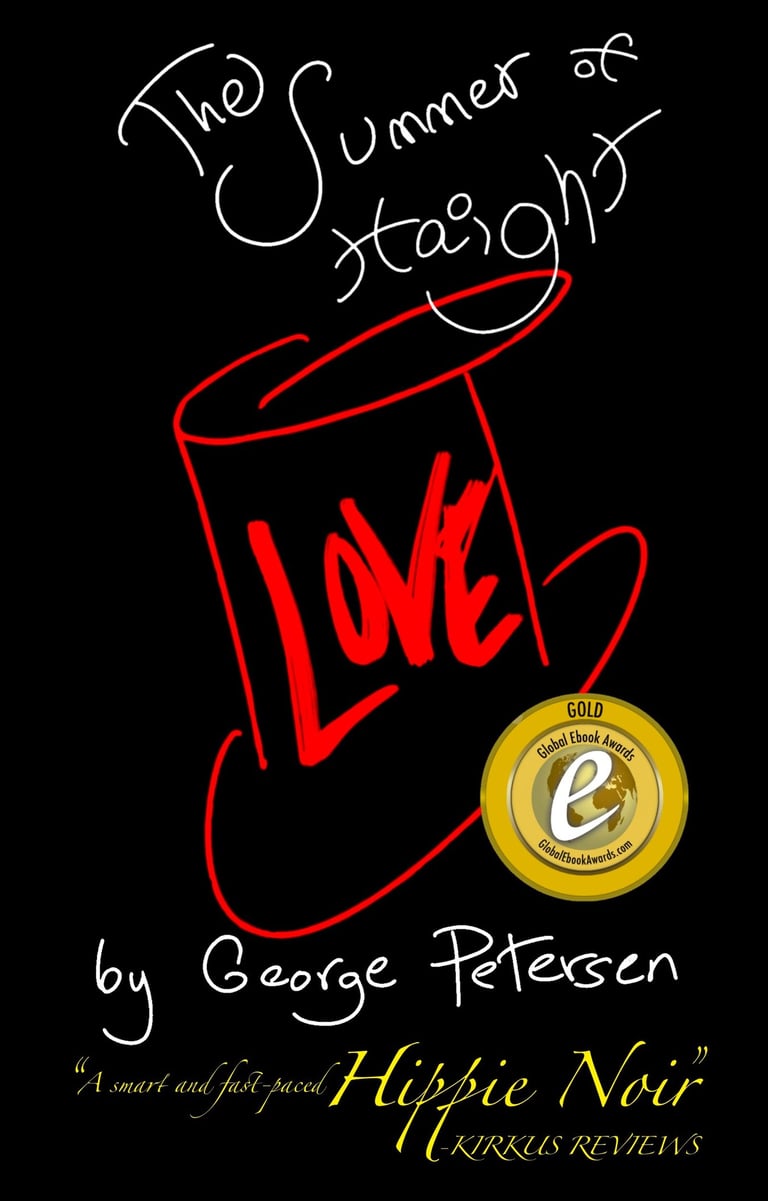A Novella by George Petersen


THE SUMMER OF HAIGHT
“ M I N D - B E N D I N G ”
—Forward Clarion Reviews ★★★★
“ E L E C T R I F Y I N G ”
“ I N T E N S E ”
—BookLife
“ H A U N T I N G ”
—Chanticleer Reviews ★★★★★
“ G R I P P I N G ”
—Readers’ Favorite ★★★★★
“ M E S M E R I Z I N G ”
—Self-Publishing Reviews ★★★★
“ E V O C A T I V E ”
—Kirkus Reviews (OUR VERDICT: ✓ GET IT)


A San Franciso attorney becomes convinced his best friend will be murdered by a mysterious hippie out to inherit his wealth.
What should an attorney do when, out of the blue, his best friend pressures him to draw up a will leaving his entire estate to a no-good hippie? A good-for-nothing hippie no one ever heard of. Investigate! That's what he should do. But his good friend not only rejects this advice but forces the attorney to make a solemn promise never to investigate the cryptic hippie beneficiary under any circumstances - not ever. The attorney finds this bizarre. Perhaps his friend is the victim of some kind of nefarious plot…? So, he decides to break his promise and follow the rogue hippie on one of his nocturnal escapades into the Haight-Ashbury. The attorney, disturbed by what he witnessed in the Haight - and wanting to save his friend from himself - now becomes obsessed with a single purpose: to unmask the debauched hippie as a provocateur flirting with fraud, blackmail and (it becomes more conceivable by the day!) murder.
The Attorney - Mild-mannered, polite, pleasant to be around. But when he becomes convinced his best friend will be murdered by a mysterious hippie, he becomes obsessed with uncovering the hippie's true identity and intentions, throwing all caution and reason to the wind.
The attorney’s friend, a Medical Researcher - Sophisticated, erudite, sensitive and empathetic. But turns inexplicably angry and vindictive when he learns his attorney has betrayed his solemn promise not to investigate a certain hippie, the new sole benefactor of his will.
The Hippie - Brooding, mysterious, and dark. He wears colorful hippie garb, but unlike the carefree hippies, his clothing oddly seems to be tailer-made. He grins a lot, but you wonder if it’s because he’s about to lunge for your throat.
AWARDS


Dan Poynter's Global Ebook Awards
Gold Medal for Mystery Fiction
2025
THE SUMMER OF HAIGHT
by George Petersen


The BookFest
The Summer of Haight
by George Petersen
Silver Award for Literary
Mystery, Thriller and Suspense
2025
EDITORIAL REVIEWS



Highly Recommended!
- Chanticleer Book Reviews
THE SUMMER Of HAIGHT by George Petersen - Surreal Fiction, 1960s, Literary Fiction, Absurdist Fiction, Magic Realis
"In The Summer of Haight, George Petersen opens a doorway into the hallucinatory dreamscape of 1967 San Francisco, where the counterculture's bright ideals are shadowed by something far more sinister.
Forget the peace signs and flower crowns. This isn't a nostalgic romp through Haight-Ashbury. It's a slow-burning gothic mystery where the air smells of something rotting just beneath the incense, and reality unravels one eerie page at a time.
The Summer of Haight centers on Longfellow, a straight-laced, impeccably dressed British lawyer living in San Francisco. He's logical, loyal, and just rigid enough to feel like he's constantly one step out of place in the groovy chaos of 1960s counterculture. His best friend, the brilliant and eccentric scientist Dr. Jonathan St. Amour, seems to be riding high—hosting elite parties, building a private laboratory under his Victorian mansion, and showing off his mysterious new pet cat, Zelda, who wears a custom-cut diamond in the shape of a cat's eye.
Things start to tilt sideways when Jonathan suddenly asks Longfellow to draft a new will—one that leaves everything to a man named Dr. Asmodeus Youngblood.
This 'Youngblood' is nobody Longfellow has ever met, and Jonathan refuses to introduce them. In fact, he makes Longfellow promise not to investigate him. Naturally, this only makes Longfellow more suspicious. What follows is a descent into something much stranger than legal drama. Youngblood isn't just a mystery; he's a walking contradiction, a man who looks like a flamboyant hippie but moves with something menacing in his step. He sleeps during the day, unnerves everyone in the house, and seems to have an unnatural hold over Jonathan. Even Zelda is terrified of him.
As Longfellow breaks his promise and trails Youngblood through the fog-choked streets of the Haight, the novel morphs into a fever dream. There are LSD-drenched parties, glowing body paint, hallucinatory visions, and ominous signs that Youngblood may not be entirely human. The scenes at the Fillmore Auditorium—strobe-lit nudity and shadowy faceless figures—feel like a cross between Eyes Wide Shut and a haunted lava lamp.
At one point, the atmosphere turns almost otherworldly: "Wide-eyed and anxious, I climbed the stairs to the auditorium, a red apple in one hand, a bright yellow balloon in the other... Janis Joplin belted out 'Summertime' on stage... tie-dye backdrops bathed in luminous liquid colors... A puppeteer hung a life-size marionette from the balcony so it could dance with the flower girls on the floor below..."
Despite the surrealism, The Summer of Haight is also about aging, longing, and identity. Jonathan's longing to be young again, to break free from the restrictions of respectability and embrace something primordial, is familiar but also terrifying. Readers will find the story clearly depicts how simple it is to lose oneself while pursuing the illusion of independence.
The prose is moody, poetic, and at times playfully gothic. There's fog, firelight, hidden blades, secret cellars, and symbolic snakes. But the pace is deliberate; it doesn't sprint. Rather, it creates a dense atmosphere that allows the reader to feel the dread.
If you like stories where a seemingly rational world starts to fray at the edges—where one must question not only the nature of the villain but that of reality itself—then The Summer of Haight by George Petersen might be your kind of delirium. It's haunting, heady, and more than a little hypnotic."


Highly Recommended!
BestThrillers.com
“The Bottom Line:
An electrifying debut that is part murder mystery, part psychological thriller, and most of all, a memorable plunge into the dark soul of the Summer of Love.
The Summer of Haight begins as British expatriate and San Francisco attorney Longfellow finds himself in the vibrant tide of the 1967 Summer of Love. While the city explodes in psychedelic colors, free love, and anti-establishment fervor, Longfellow clings to the rules and order that govern his life and profession. A shock of unwelcome change comes when close friend and fellow expatriate Jonathan reveals that he intends to leave his entire fortune to a shadowy new acquaintance, Dr. Asmodeus Youngblood.
Jonathan wants Longfellow to write the will and make it “bulletproof.” But Longfellow, who has never even heard of Youngblood, is alarmed. Subsequently, Longfellow is contacted by Jonathan’s butler, Alfred, who suspects that Youngblood has strangled Jonathan’s cat. What’s more, he reports that Jonathan has given Youngblood the run of the house, with the staff up at all hours of the night at his beck and call.
Turning amateur sleuth for the sake of his friend, Longfellow and pooch pal Winston follow Youngblood through San Francisco’s fog-drenched underground before confronting him. But Longfellow won’t be working alone. Author George Petersen pairs Longfellow with Detective Maggie Shaughnessy, who serves as a confident, direct and unfiltered counterbalance to her former love interest. Intriguingly, Shaughnessy is in the midst of investigating the murder of several young women.
One of the most striking aspects of The Summer of Haight is how deftly George Petersen subverts the romanticized vision of the “Summer of Love” by layering it with dread, death and disillusionment. While 1967 San Francisco is historically remembered as a haven for peace, music, and flower power, Petersen flips the script to expose a darker undercurrent beneath the tie-dye and acid trips. Even as Petersen uses real world icons – The Grateful Dead, The Merry Pranksters, Janis Joplin and more make up the artistic tapestry – the book’s noir lens reveals how irrational idealism and naivete create opportunities for predators.
Themes of transformation, identity, and corruption ripple through the novel. Jonathan’s fascination with snakes and metamorphosis becomes a dark metaphor for his yearning to escape human responsibility. This descent into philosophical madness is paralleled by the city around him, where innocence is devoured under the guise of freedom.”


Self-Publishing Reviews
Mesmerizing, deviant, and steeped in counterculture madness, The Summer of Haight by George Petersen is a psychedelic thriller that dares readers to interrogate their animal nature, and even question their grasp on reality. Set against the legendary backdrop of 1967, this Summer of Love story follows a tangled trio as they navigate existential dilemmas and psychedelic schemes across the highs and lows of San Francisco.
Jonathan St. Amour is a secretive psychiatric researcher and a snake-loving socialite who appears to be spiraling into a midlife crisis, despite his debonair attitude and lavish dinner parties. Longfellow is his loyal friend, lawyer, and fellow British expat whose suspicions are aroused when his cat-crazed chum rewrites his will, stubbornly insisting on leaving a small fortune to a decidedly shady hippie named Dr. Asmodeus Youngblood. Ever the voice of reason, Longfellow begins to investigate this bizarre beneficiary, despite Jonathan’s clear warning not to dig into his dramatic decision.
What begins as due diligence and a desire to protect his best friend from suspected blackmail soon morphs into a mind-bending odyssey through the depths of debauchery, careening from smoke-laced basements and feverish dance floors to clandestine stakeouts, harems of impish flower girls, and the iconic Human Be-In of 1967. Slowly peeling back the layers of the mystery, Longfellow must shed his buttoned-up attitude if he wants to infiltrate the starry-eyed inner circle of San Francisco and save his friend from ruin and regret.
Character development is king for Petersen, not only for the main players, but the foils as well, from the embittered Detective Shaughnessy and the chronically worried Millie to Longfellow’s precious dog, proving that there are no small parts in theatre. Youngblood is a masterfully drawn character, a puckish trickster who swerves between mystical and malevolent, perpetually leaving readers one step behind his motives and true nature. Longfellow and Jonathan are a delightfully odd couple at the center of this drama – two male characters marked by such unabashed care and compassion for each other are a refreshing rarity in modern literature.
Beyond the deliriously weird plot, the novel’s explorations of self-discovery and bold boundary pushing are inspiring, albeit disturbing at times. Dancing at the edge of magical realism with its drug-induced drama, and coupled with an occasionally untrustworthy narrator, this is a farcical tour de force that never takes itself too seriously, nor fully shows its cards. Novels inspired by the revolutionary era of free love and radical thinking are not entirely rare, but this one crackles with tongue-in-cheek mischief, as if John Kennedy Toole, Kurt Vonnegut, and Tom Wolfe conspired to craft a flashback classic.
The prose is occasionally blunted by overly procedural narration, extolling the minutiae of physical movements and other unnecessary details that slow the typically steady pace. The abrupt chapter breaks for brief asides or unremarkable cut scenes can be interruptive and choppy, as opposed to the italicized dream sequences that imbue the writing with slow-burning gothic suspense.
Aside from these infrequent stumbles in execution, this is a visionary, sometimes hallucinatory work of fiction, cleverly layered with nostalgia, philosophy, comedy, noirish drama, and a deliciously odd plot that revels in its eccentricity.




Forward Clarion Reviews
The intriguing historical mystery novel The Summer of Haight is narrated with an undercurrent of surrealism.
In George Petersen's whimsical mystery novel The Summer of Haight, 1960s San Francisco is subjected to intrigue and otherworldliness.
During the Summer of Love, Longfellow, a British expatriate and attorney who is logical and conservative by nature, feels out of touch with his eccentric neighbors, who embrace psychedelic color schemes, incense, and free love. Even his best friend Jonathan revels in in the counterculture, hosting lavish parties in his mansion with his spoiled cat, Zelda, at his side. But when Jonathan asks Longfellow to draft a will leaving his possessions to mysterious Asmodeus, Longfellow is prompted to investigate. Assisted by his canine companion, Winston, and a detective, Maggie, Longfellow looks into Asmodeus and discovers that the Haight-Ashbury neighborhood has a sinister side. His methodical investigation, which is fed by his sense of loyalty, morbid curiosity, and an ever-evolving understanding of the world around him, gives way to uncharacteristic recklessness, putting him in danger.
Narrated with an undercurrent of surrealism, the book contrasts Longfellow's straightforward perspective with parties and other experiences that feel like fever dreams. Longfellow's forays out of his comfort zone both mask and accentuate the idiosyncrasies of the characterizations, as with Jonathan's recent and increasing brooding and Asmodeus's outlandishness, including his daytime sleeping habits and innate ability to unnerve even Zelda, despite his tailored flower-power outfits. Throughout the narrative, his presence inspires dread, his friendly grin tinged with menacing intent. There are plausible explanations for most of what Longfellow observes, but they command less attention than his new obsession and Jonathan's sudden, inexplicable fascination with snakes and metamorphosis.
Maggie's investigation into the recent murders of several young women-tragedies that occur soon after Asmodeus infiltrates Jonathan's life and household-seems unrelated at first, though they are a compelling, dark element in the backdrop of the carefree hippie counterculture that Longfellow fears. The world seems to be leaving behind the rules and norms that once governed it; thus, the settings are developed in terms of juxtapositions. Bright colors and deep shadows go hand in hand, accentuating significant sites like the Fillmore. As the story transitions between Longfellow's everyday tasks and schedules and the oddities that he encounters, the intertwined mysteries are unraveled at a steady rate. Stark verbiage also trades with poetic prose as Longfellow's trains of thought vacillate; at times, he feels helpless before forces he can't see or comprehend.
The Summer of Haight is a mind-bending mystery novel set amid eerie gray areas and unsettling cultural phenomena.
KATELYNN WATKINS (September 2, 2025)


Readers' Favorite
“George Petersen brings readers a fascinating thriller with The Summer of Haight. It's the year 1967. Longfellow is one of the most respected attorneys in San Francisco. When his best friend, Jonathan, an internationally renowned psychiatric researcher, seeks his help in writing his will, Longfellow is taken aback by Jonathan's wish to leave all his assets to a stranger named Asmodeus Youngblood, whom Longfellow suspects of being a dangerous hippie. Jonathan forbids Longfellow from investigating Youngblood. However, Longfellow is convinced that Youngblood is somehow manipulating Jonathan and follows him throughout the Haight-Ashbury neighborhood. As Jonathan becomes increasingly delusional, Longfellow seeks help from his friend, Maggie, a detective in the SFPD. Meanwhile, "flower girls" are being murdered by a crazed maniac all over the city. Can Longfellow rescue Jonathan from Youngblood's clutches?”
The Summer of Haight is a gripping tale full of suspense and intrigue. Author George Petersen teases the reader until the end by layering the narrative with a hint of the supernatural. It enhances the mystery and builds an atmosphere of tension and anticipation that is immersive. The plot is very well-paced, and the twists and turns keep you engaged all the way through. Every main character has an underlying layer of mystery to them that makes you want to know more. Petersen also infuses a bit of dark humor into the story. I particularly enjoyed Longfellow's inner monologues and his banter with Maggie. The climactic action scene toward the end will have readers biting their nails. On the whole, this was a very entertaining tale. Mystery readers are going to love this one!”


BookLife Reviews
As published in Publishers Weekly
September 29, 2025
"It’s the summer of 1967, and Mr. Longfellow, a well-known British attorney, is ambling the streets of San Francisco on his way to a housewarming party for his dear friend and client, Jonathan St. Amour. During the soiree, St. Amour wows the crowd with his new underground laboratory—and shocks Longfellow with an odd request: a pre-constructed will, in which he has left his considerable wealth to the enigmatic Dr. Asmodeus Youngblood. Though Longfellow has no knowledge of Youngblood—and St. Amour is hesitant to share many details—he sleuths around and learns that Youngblood has taken up residence in St. Amour’s lab. Meanwhile, flower girls are being murdered throughout the city, and Longfellow is having recurring nightmares about a faceless, hooded creature intertwined with their deaths.
Petersen’s twist on Robert Louis Stevenson’s Strange Case of Dr. Jekyll and Mr. Hyde starts out a bit disjointed but eventually finds its legs and drives the story to a satisfying conclusion. The sense of urgency spirals when Longfellow discovers St. Amour’s beloved cat has been strangled, prompting him to join forces with Maggie Shaughnessy, a detective from his past, to uncover the truth. Longfellow’s belief that Youngblood is a hipster—and his mistrust of that potential status—accentuates the ideological clashes that defined the ‘60s subculture, playing out in scenes where Longfellow steals through the fog-lined streets of San Francisco’s Haight-Ashbury neighborhood in pursuit of an “indigo plush velvet” clad Youngblood who is frequenting midnight raves.
Petersen teases readers with organic suspense—the discovery of a murder weapon linking Youngblood to the city’s slaughters, followed by his sudden disappearance—that boosts the story’s thriller elements, while counterbalancing its tenser moments with the developing closeness between Longfellow and Shaughnessy. The ending compels, falling back on classic Jekyll and Hyde elements while offering a studied contemplation on what it truly means to be free."
Takeaway: Intense, layered thriller with startling atmosphere.
Comparable Titles: Alexander Bayliss’s Jekyll and Hyde, Ray Bradbury’s Something Wicked This Way Comes.
Production grades
Cover: A-
Design and typography: A
Editing: A
Marketing copy: B-


Kirkus Book Reviews
OUR VERDICT: ✓ GET IT
Petersen’s novel offers a winning Summer of Love take on Dr. Jekyll and Mr. Hyde.
Mr. Longfellow (whom everyone simply calls Longfellow) is a British expatriate living in San Francisco and working as an attorney. The year is 1967, it’s the first weeks of the Summer of Love, and he’s having foreboding dreams about dead hippie girls. That’s not the only strange thing happening: When Longfellow visits his fellow British expatriate and psychiatric researcher friend Jonathan St. Amour, the Good Doctor, as Jonathan is known, leads him through his impressive new laboratory with its “long row of glass cages filled with snakes of every conceivable size and variation, all slithering about and hissing and showing off their tongues.” Jonathan lectures Longfellow and other gathered guests about his recent study of transmogrification, the ability to “unleash the will to be whatever we wanted to be.” Even more curious than this is the Good Doctor’s request to Longfellow regarding the alteration of Jonathan’s will—he wishes to bequeath his life earnings to a man unknown to Longfellow in the event of an unexplained absence for any period exceeding three months. This unknown man, Dr. Asmodeus Youngblood, soon moves in with the Good Doctor and begins running the home. Longfellow takes it upon himself to start following Youngblood, a hippie who wears “a tall top hat tilted rakishly low on his forehead. The word ‘LOVE’ had been painted in bold white brush strokes across the black felt. He was dressed in a long, full-length indigo plush velvet coat, with the collar flipped up, covering his face and ears.” Longfellow becomes convinced that Dr. Youngblood is planning to do away with Jonathan and enlists the help of his ex-girlfriend, a detective named Maggie Shaughnessy, to figure out what’s going on. His suspicions intensify when a young girl is found dead and he becomes convinced that Dr. Youngblood is her killer. Intercut with scenes of the investigation are Longfellow’s visions and dreams, presented as italicized poems as he tries to connect the swirling dots of the case.
The story will read as familiar to anyone acquainted with Robert Louis Stevenson’s original Strange Case of Dr. Jekyll and Mr. Hyde (1886)—Petersen acknowledges the obvious precedent in the afterword. Like the original, this story is fleet-footed, moving quickly from scene to scene in short chapters in which the author displays an impressive command of atmosphere. Petersen captures the textures of the era and the unease that the relatively straight-laced Longfellow feels as he is forced to navigate the Fillmore and various hippie gatherings: “I saw a sea of hippies blowing whistles, counting their toes, diddling with kinetic sculptures that ‘thundered’ when struck, sharing with each other their feathers, whistles and curious pebbles.” In creating Longfellow and giving him an obedient Schnauzer who comes along on his investigations, the author has also potentially decanted formula for a new detective series, should he decide to pursue it. Even if the solution to the central mystery may appear obvious to readers early in the story, the evocative first-person narration by Longfellow will still keep them reading.
A smart and fast-paced hippie noir.
Story Questions
What was The Summer of Love?
Who is Longfellow and why doesn't he have a last name?
What did Jonathan really want? He had everything. Why was he so unhappy?
Was Asmadeus a bad person or a good person?
Why did plush Victorian houses have a bright, engaging front and a dark, foreboding back?
What buildings in The Summer of Haight still stand today?
Where did the hippies come from?
Would the hippies ever have existed without the Vietnam War?
Was Stevenson a hippie?
Places to Visit: The Counter History Museum at Haight and Ashbury; The Stevenson Museum in St. Helena, California; The Stevenson Museum in Monterey, California.
Would a real woman do what Maggie did?
Purchase Book
Amazon
Apple Books
Barnes and Noble Nook
Kobo
Contact
thesummerofhaight@gmail.com
